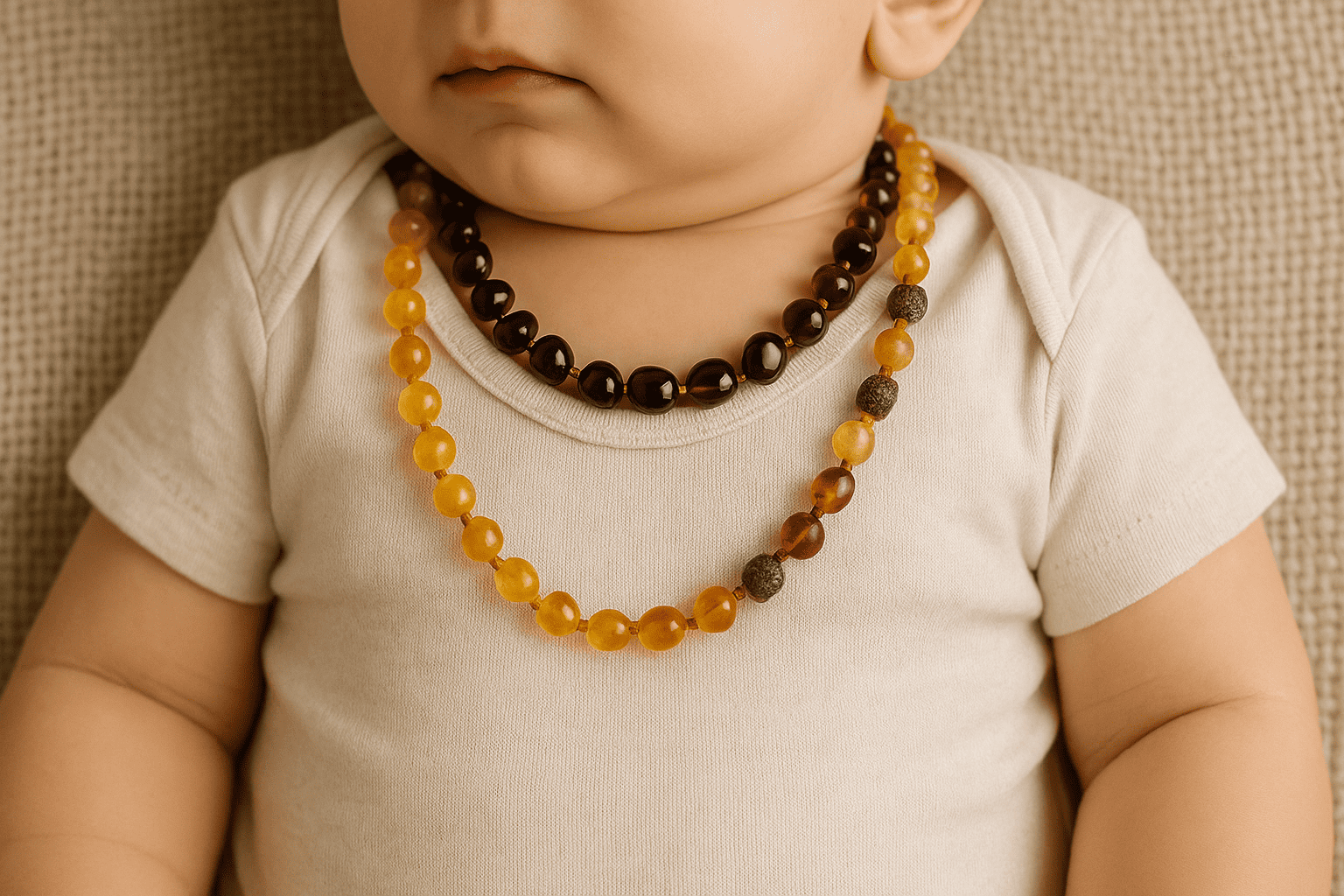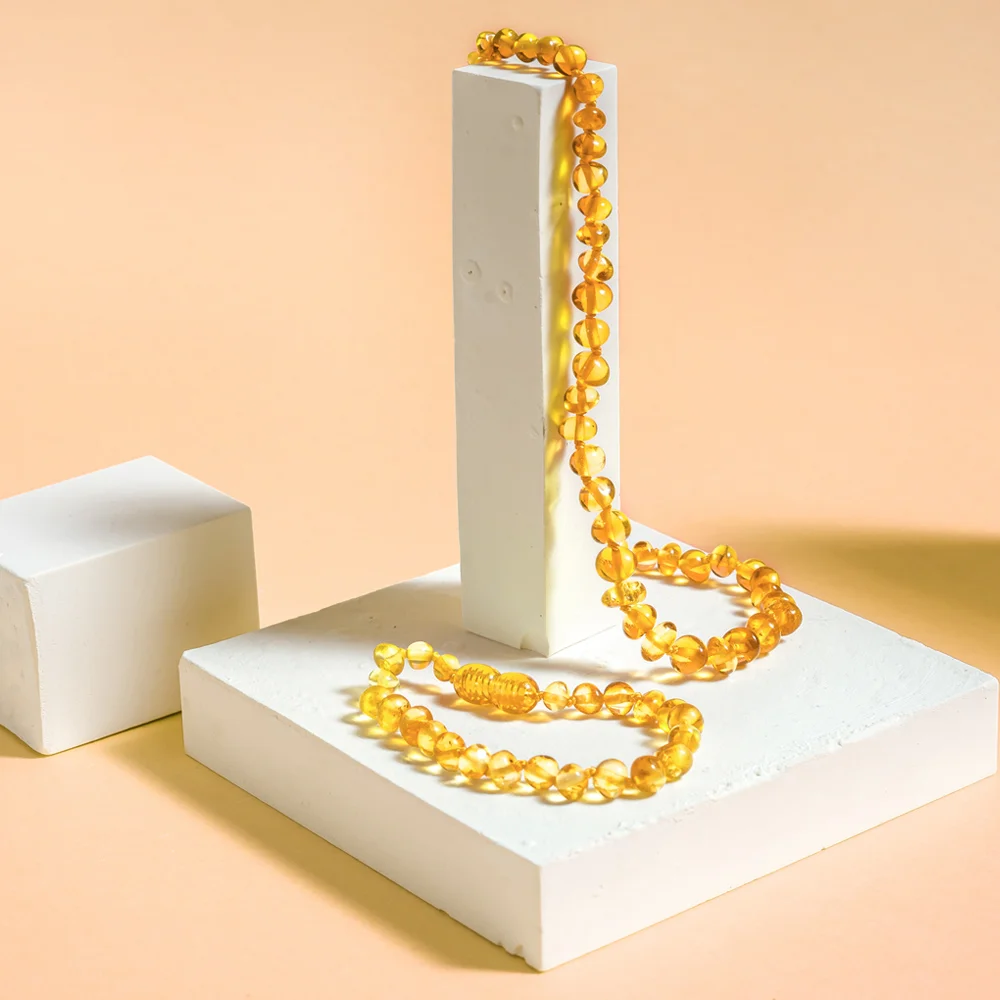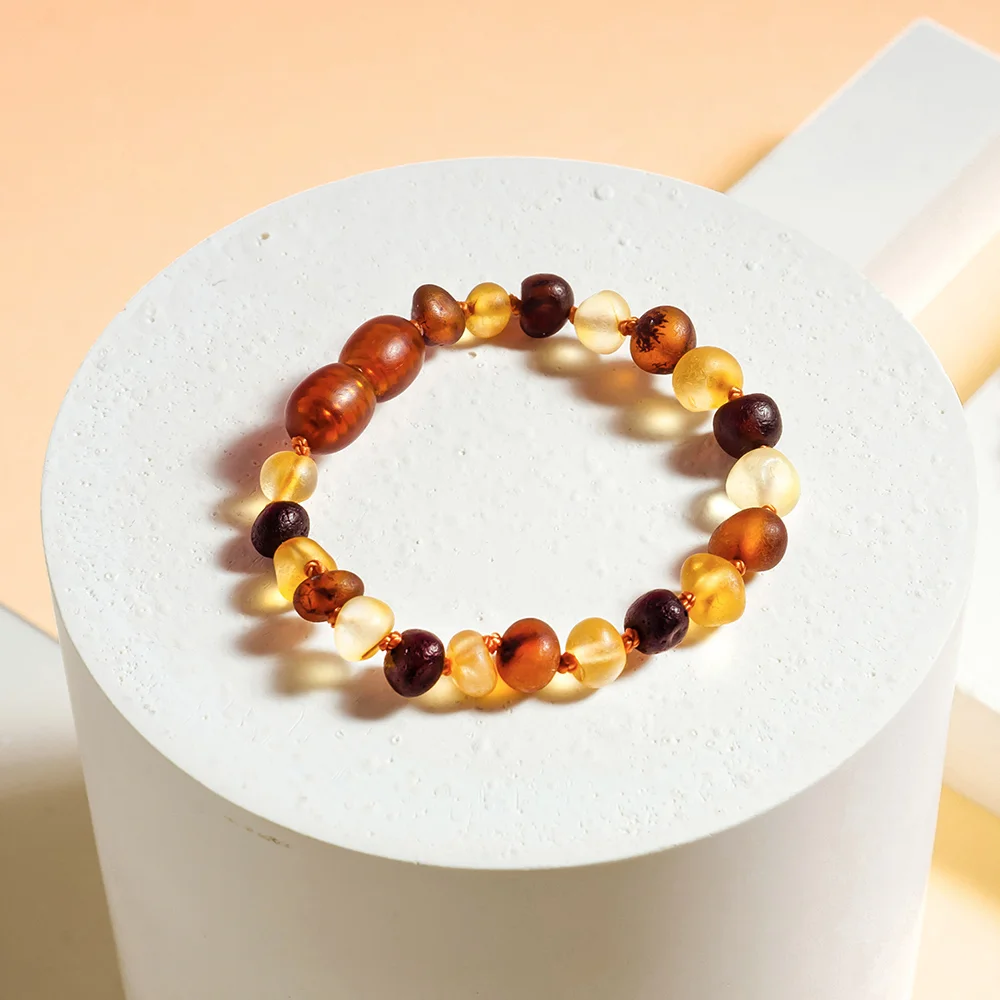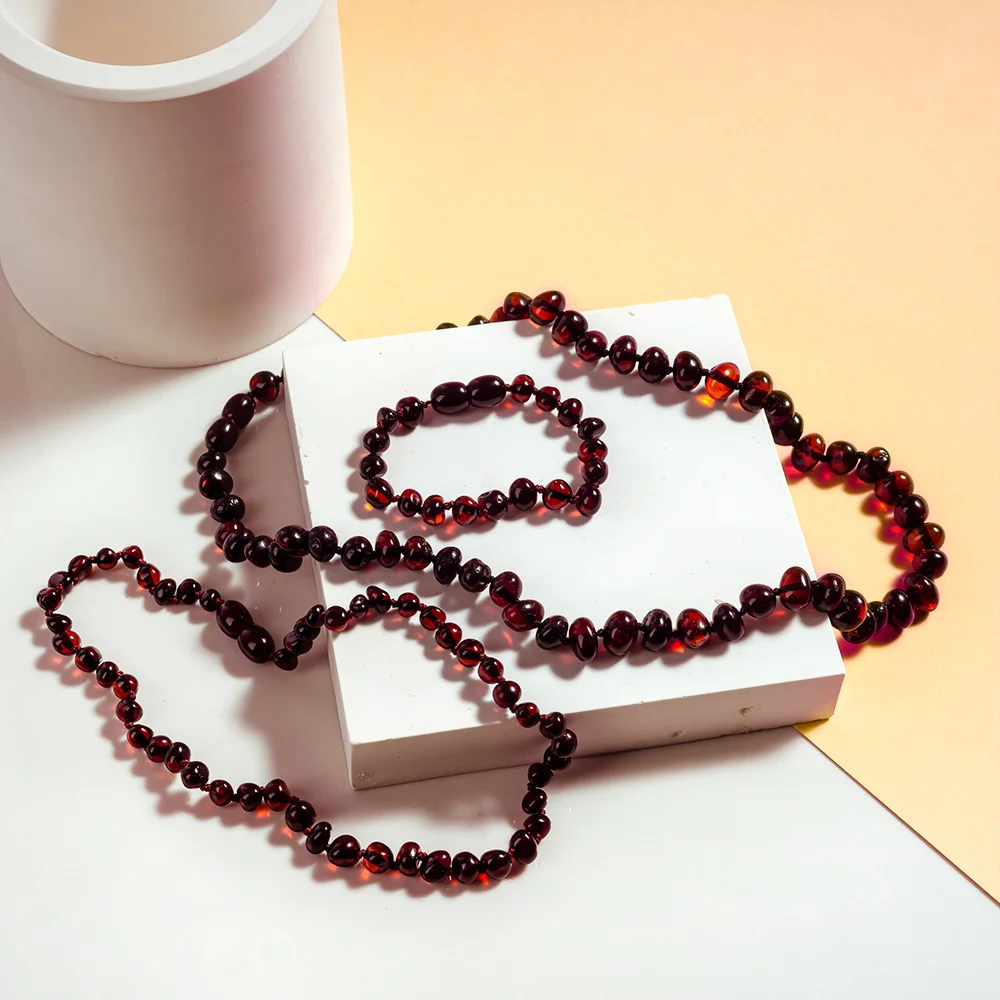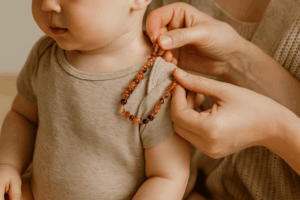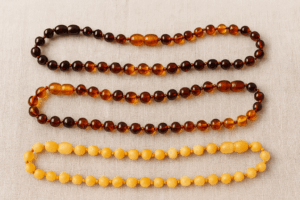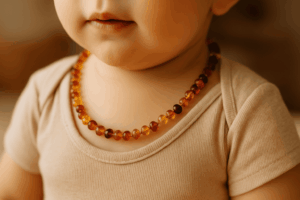Teething can be a challenging chapter for both babies and parents. Between the drooling, red cheeks, and sleepless nights, it’s natural for caregivers to look for gentle, non-invasive ways to soothe their little ones. For centuries, families in Baltic and European cultures have turned to a simple yet beautiful accessory: the amber teething necklace.
In recent years, these necklaces have gained global popularity, not only for their warm, honey-like beauty but also for the belief that they may bring comfort during teething. But what exactly is an amber teething necklace, and how is it thought to work? Understanding both the tradition and the theory behind these necklaces can help parents decide whether they fit into their approach to teething care.
What Is an Amber Necklace for Teething?
An amber teething necklace is a string of small, rounded amber beads designed to be worn around a baby’s neck — never for chewing, but to rest directly against the skin. Traditionally made from genuine Baltic amber, these necklaces are lightweight and warm to the touch, making them comfortable for everyday wear (always with supervision).
Baltic amber is fossilized tree resin that formed millions of years ago along the shores of the Baltic Sea. It is prized for its natural inclusions, variety of colors — from pale milky yellow to deep cognac — and, most notably, its succinic acid content. Succinic acid is a naturally occurring substance found in certain plants, foods, and even in the human body as part of our energy cycle. Supporters believe that when amber beads rest against warm skin, tiny amounts of succinic acid may be released and absorbed, potentially providing a calming or pain-relieving effect.
These necklaces are often given as gifts around the time a baby’s first teeth begin to emerge, usually between four and seven months of age. While the concept is rooted in tradition, their appeal today combines aesthetics, cultural heritage, and the hope of easing teething discomfort in a natural way.
A Brief History of Amber and Teething Traditions
Amber has been treasured for thousands of years — not just as jewelry, but as a symbol of protection, comfort, and vitality. Archaeological evidence shows that amber necklaces for babies were worn in parts of Europe as far back as the Bronze Age. In Baltic cultures, it was believed that amber carried the warmth of the sun and could protect children from discomfort and illness.
Over time, this tradition evolved into the modern amber teething necklace for infants. While today’s parents may choose them for different reasons, the underlying belief has stayed the same: that amber can help bring calm during teething. The idea of what an amber teething necklace does is rooted in the same principles as in ancient times — the close contact with the skin is thought to allow the amber’s natural properties to support comfort and well-being.
In the past, amber was often given as a newborn gift, intended to be worn when the first teeth appeared. Even without modern science to explain the process, families passed down the practice through generations, keeping alive the belief in the benefits of wearing amber during teething. Today, this tradition has spread worldwide, and many parents still choose what they believe to be the best amber necklace for teething based on quality, authenticity, and safety.
How an Amber Teething Necklace Is Believed to Work?
For many parents, the biggest question is simple: why do amber necklaces help with teething — or at least, why do so many believe they do? The explanation comes down to a naturally occurring compound called succinic acid, found in the highest concentration in Baltic amber.
The theory is that when a baby or infant wears a genuine amber teething necklace against their skin, body warmth may help release trace amounts of this substance. Supporters believe succinic acid could be absorbed through the skin and act as a natural anti-inflammatory and mild pain reliever. This, they say, could help soothe sore gums, reduce fussiness, and bring a gentle calming effect during the teething process.
While research on this process is limited, many parents report perceived benefits of amber teething necklaces, describing their children as more settled and less irritable while wearing them. Others appreciate them as a natural, non-invasive option that doesn’t involve medication.
Choosing the best amber necklace for teething often comes down to selecting high-quality Baltic amber beads, ideally hand-knotted for safety and comfort. Some parents prefer lighter “milky” amber, while others choose deep cognac or cherry tones — the color is mostly a matter of preference, as supporters believe all authentic Baltic amber contains succinic acid regardless of shade.
For those who follow the tradition, the benefits are twofold: the possibility of physical relief and the cultural comfort of using a method passed down through generations. Whether viewed as a natural wellness aid or a beautiful keepsake, the amber teething necklace remains one of the most recognizable and talked-about teething accessories in the world.
Is There Scientific Evidence for Amber Teething Necklaces?
When it comes to understanding what an amber teething necklace does, it’s important to look at both tradition and science. The traditional belief is clear — that succinic acid from Baltic amber, released through skin contact, may help with inflammation and discomfort during teething. But what does the research say?
Currently, there is no conclusive scientific evidence proving that wearing an amber necklace for teething directly reduces pain in babies or infants. Studies on succinic acid have shown anti-inflammatory and antioxidant properties in laboratory settings, but there is no peer-reviewed research confirming that these effects occur when amber is worn against the skin.
Pediatricians and child safety organizations often caution against leaving an amber teething necklace on a sleeping baby due to the risk of choking or strangulation. For this reason, most experts recommend supervised wear only and removing the necklace during naps or nighttime sleep.
That said, many parents still choose to use them — sometimes as part of a broader approach to teething care that includes cold washcloths, silicone teethers, and gum massages. They value the necklaces for their benefits beyond any potential pain relief: cultural heritage, aesthetic beauty, and the sense of giving their child something natural and traditional.
In short, while science has yet to confirm why amber necklaces help with teething in measurable terms, anecdotal reports and long-standing cultural traditions keep the practice alive for many families. The key is mindful, safe use, paired with realistic expectations.
Why Some Parents Still Choose Amber Teething Necklaces?
Even without definitive scientific proof, many parents continue to believe in the benefits of amber teething necklaces. For some, the decision is rooted in family tradition — their own parents or grandparents may have used amber during teething, making it a sentimental choice. For others, it’s about wanting a natural, non-invasive option to complement other teething remedies.
Parents who choose the best amber necklace for teething often talk about the beauty of the beads and the unique look they bring to their baby’s outfit. Beyond style, there’s the idea that amber connects their child to something ancient and timeless. Baltic amber is millions of years old, and each bead carries a small piece of Earth’s history. Wearing it becomes more than just a teething aid — it’s a symbolic gesture of care and connection.
For some caregivers, the answer to what an amber teething necklace does is as much emotional as it is physical. Even if the pain-relief effect is uncertain, the necklace can become a comforting ritual, something their child wears during the day that signals calm and familiarity.
Many also appreciate that amber necklaces require no batteries, no refrigeration, and no direct chewing — unlike silicone or wooden teethers. As long as they’re worn for babies and for infants with proper supervision and safety measures, they can be part of a low-maintenance approach to teething support.
Ultimately, the choice often comes down to personal preference. Parents weigh the tradition, appearance, and anecdotal results, then decide whether an amber necklace fits into their baby’s teething care routine.
Safety Considerations for Amber Teething Necklaces
While many parents are curious about the benefits of wearing amber teething necklaces for babies and for infants, safety must always come first. The necklaces are not toys, and they are not meant for chewing. Instead, they are designed to rest lightly against the skin, allowing body warmth to interact with the amber beads.
Most pediatricians and safety organizations advise that amber teething necklaces should be worn only under supervision. That means removing them during naps, nighttime sleep, or when a caregiver cannot directly watch the child. This precaution reduces the risk of choking or strangulation.
If you’re choosing the best amber necklace for teething, look for these key safety features:
- Individually knotted beads so that if the necklace breaks, only one bead will come loose.
- Breakaway clasps that release under pressure.
- Appropriate length (usually 12–13 inches) to minimize slack without being tight.
Another important tip is to avoid letting your baby chew on the beads. Amber is relatively soft compared to other gemstones, and biting could damage the beads or pose a choking hazard.
Parents who want the benefits of amber but worry about necklaces sometimes opt for amber bracelets or anklets instead, which can be worn under clothing where the child can’t easily reach them.
By pairing proper safety precautions with mindful, supervised wear, parents can enjoy the aesthetic and cultural value of amber teething necklaces while minimizing potential risks.
How to Choose a Quality Amber Teething Necklace?
Not all amber jewelry is created equal, and when it comes to something your baby will wear, quality matters as much as appearance. Choosing the best amber necklace for teething means looking for authenticity, craftsmanship, and safety.
Genuine Baltic amber is considered the gold standard because it contains the highest natural concentration of succinic acid. This fossilized tree resin comes from the Baltic Sea region and has been valued for centuries for its beauty and perceived wellness properties. If you want to be confident in the benefits your necklace may offer, make sure it’s made from 100% authentic Baltic amber, not plastic or synthetic imitations.
Color choice is mostly personal — from pale milky yellow to deep cognac or cherry tones — but authenticity should always take priority over appearance. While some sellers claim certain colors contain “more” succinic acid, there’s no scientific proof that one shade is significantly more effective than another.
For safety, look for:
- Individually knotted beads to prevent scattering if the strand breaks.
- Breakaway safety clasps designed to release under tension.
- A length short enough to rest comfortably against your baby’s skin without hanging too low.
When buying for babies or for infants, choose from reputable sellers who provide proof of authenticity and clear safety guidelines. Avoid necklaces that look overly perfect — real amber often has tiny imperfections or inclusions that confirm its natural origin.
The right necklace should not only be safe and authentic but also durable enough to withstand daily wear. By investing in quality, parents can feel more confident that they’ve chosen the best amber necklace for teething — one that’s both beautiful and responsibly made.
Caring for an Amber Teething Necklace
Once you’ve found the best amber necklace for teething, proper care is essential to keep it safe, clean, and beautiful. Amber is not a gemstone but fossilized tree resin, which means it’s softer and more delicate than many other jewelry materials. With mindful care, your necklace can last through the teething years and beyond as a keepsake.
Cleaning should be gentle. For amber necklaces for babies or for infants, simply wipe the beads with a soft, damp cloth and let them air dry in a shaded area. Avoid soaking the necklace in water for long periods and never use harsh chemicals, alcohol, or vinegar, as these can damage the amber’s surface.
If the beads begin to lose their shine over time, you can rub them lightly with a drop of olive oil on a soft cloth, then wipe off any excess. This helps restore the warm glow that makes amber so appealing.
Storage matters too. Keep the necklace in a soft pouch or a separate compartment of a jewelry box to prevent scratches. Avoid leaving it in direct sunlight or exposing it to high heat, such as in a hot car, as extreme temperatures can cause cracks.
By following these simple steps, you can maintain both the look and potential benefits of your amber teething necklace, ensuring it remains safe for your child to wear and beautiful as a lasting reminder of their early years.
Final Thoughts — Tradition, Beauty, and Mindful Use
The amber teething necklace has a long history, blending beauty, tradition, and the hope of comfort during one of a baby’s first big milestones. For some parents, the choice is deeply cultural; for others, it’s about exploring natural, non-invasive options alongside more conventional teething remedies.
Understanding what an amber teething necklace does — and just as importantly, what it may not do — is key to making an informed decision. While science has yet to confirm that amber’s succinic acid offers measurable teething relief, the necklaces remain cherished by many families for their benefits beyond pain relief: a connection to history, an aesthetic appeal, and the symbolism of giving something special to a little one.
If you choose the best amber necklace for teething, whether for babies or for infants, make safety your first priority. Ensure it’s made from genuine Baltic amber, fits properly, and is worn only under supervision. With mindful use and proper care, an amber teething necklace can be more than just an accessory — it can be a keepsake of your baby’s earliest years, a reminder of the comfort and care you gave during their teething journey.
Ultimately, whether you see it as a wellness aid, a cultural tradition, or simply a beautiful piece of jewelry, the amber teething necklace’s place in parenting conversations isn’t likely to fade anytime soon. As long as parents approach it with open eyes, realistic expectations, and a focus on safety, it can be a meaningful and memorable part of your baby’s story.
Frequently Asked Questions (DUK)
What does an amber teething necklace do?
An amber teething necklace is worn against a baby’s skin. Supporters believe that the warmth of the skin may release trace amounts of succinic acid from the amber, which could help soothe teething discomfort. While science hasn’t proven this effect, many parents value the necklace for its traditional and aesthetic appeal.
Why do amber necklaces help with teething?
The belief comes from the natural properties of Baltic amber. Its succinic acid content is thought to have anti-inflammatory and mild pain-relieving properties, which some parents feel help reduce gum soreness and fussiness during teething.
Is an amber teething necklace safe for my baby?
It can be safe if used properly: only under adult supervision, removed during sleep, and made with safety features like individually knotted beads and breakaway clasps. It should never be chewed on.
What is the best amber necklace for teething?
The best choice is one made from 100% genuine Baltic amber, hand-knotted for safety, and the right size for your baby. Reputable sellers should provide proof of authenticity.
Can my baby wear an amber necklace all day?
Yes, during waking hours with supervision. Remove it at nap time, bedtime, or any time the baby isn’t being closely watched to prevent choking or strangulation risks.
Are there benefits of amber teething necklaces beyond teething relief?
Yes. Many parents appreciate them for their beauty, connection to tradition, and as a natural, non-invasive accessory for babies and infants. Even if the pain-relief effect is uncertain, the necklace can be a meaningful keepsake.

